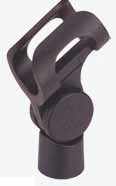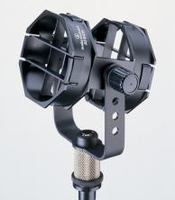![]() Two of the worst problems that plague location sound recording are rumble and wind noise.
Two of the worst problems that plague location sound recording are rumble and wind noise.
Rumble can be defined as unwanted bass vibrations transmitted through objects into the mic capsule itself. Examples of rumble include ground or floor vibrations caused by nearby traffic, heavy footsteps, and building/structural vibrations. In addition to rumble, a closely related malady is that of handling noise -- created by the friction or light tapping of human fingers, either directly against the microphone itself or conducted through whatever means by the microphone is supported (e.g. fishpole).
Merely filtering out the low frequencies at a mixing panel will not correct the whole problem. Low frequencies can quickly overload the pre-amplifiers of some microphones and most recorders. To avoid the risk of permanent audio distortion on your tracks, these low frequencies should be controlled before the signal is processed by the mic electronics (which is where pre-amps come in).
The solution to rumble lies in isolating the microphone from these vibrations by some means of free-floating suspension or non-conductive insulation -- which is the role of a good shockmount.
Not to b e confused with shockmounts are microphone clamps. Although both are intended to fulfill support functions, the difference is that a clamp is merely designed to hold a microphone, not to isolate it from vibration. Clamps are manufactured from conductive, hard materials such as plastics and metal.
e confused with shockmounts are microphone clamps. Although both are intended to fulfill support functions, the difference is that a clamp is merely designed to hold a microphone, not to isolate it from vibration. Clamps are manufactured from conductive, hard materials such as plastics and metal.
Because mic clamps (sometimes referred to as mic stand adapters/holders) are cheap to manufacture, they are supplied free with most microphones. You’ll often find boxes full of them in the A/V supply rooms.
Although clamps may be acceptable for use with relatively insensitive (dynamic) mics such as those found in hotel conference rooms, they should not be used with the highly sensitive shotgun mics associated with professional film and video production.
An example of a mic clamp,
made by Canford
Instead, make it a habit to always use an isolation shockmount.
A good shockmount does not have to mean big bucks. For example, some of the most popular shockmounts in use by the professional film and video industry sell for under seventy-five dollars!
Without a doubt, the overall most popular shockmount in use by the video industry is the model AT8415 "rubber band mount" manufactured by Audio Technica (seen right). This inexpensive universal shockmount consists of two pair of thick rubber bands arranged tic-tac-toe fashion within a cylindrical framework. The mic is held inside of the "center square" of the grids formed by the rubber bands.
